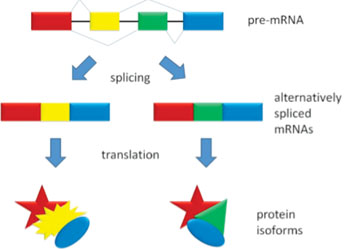Key Regulator of Cancer-Inducing Alternative Splicing Identified
By LabMedica International staff writers
Posted on 18 Sep 2014
Cancer researchers have identified the splicing factor RBM4 (RNA-binding protein 4) as a key determinant in processes that prevent tumor development and spread.Posted on 18 Sep 2014
RBM4 is known to be crucial to gene splicing by minimizing the effects of cancer-inducing alternative splicing. Alternative splicing is a process by which the exons of the RNA produced by transcription of a gene are reconnected in multiple ways during RNA splicing. The resulting different mRNAs may be translated into different protein isoforms, thereby allowing a single gene to code for multiple proteins.

Image: Alternative splicing produces two protein isoforms (Photo courtesy of Wikimedia Commons).
Alternative splicing occurs as a normal phenomenon in eukaryotes, where it greatly increases the biodiversity of proteins that can be encoded by the genome. In humans about 95% of multiexonic genes are alternatively spliced. Numerous modes of alternative splicing have been observed, of which the most common is exon skipping. In this mode, a particular exon may be included in mRNAs under some conditions or in particular tissues, and omitted from the mRNA in others. Abnormal variations in splicing have also been implicated in disease, since a large proportion of human genetic disorders result from splicing variants. Abnormal splicing variants are also thought to contribute to the development of cancer.
RBM4 activity was found to be reduced in patients with certain types of cancer, including lung and breast cancers, while higher levels of activity correlated positively with improved prospects for survival. Investigators at the University of North Carolina (Chapel Hill, USA) sought to clarify how RBM4 prevented alternative splicing.
They reported in the September 8, 2014, issue of the journal Cancer Cell that RBM4 suppressed proliferation and migration of various cancer cells by specifically controlling cancer-related splicing. Particularly, RBM4 regulated Bcl-x splicing to induce apoptosis, and coexpression of Bcl-xL partially reversed RBM4-mediated tumor suppression.
The pro-survival protein BCL-xL is often overexpressed in solid tumors and renders malignant tumor cells resistant to anticancer therapeutics. BCL-xL (B-cell lymphoma-extra-large) is a transmembrane molecule in the mitochondria. It is a member of the BCL-2 family of proteins, and acts as a pro-survival protein by preventing the release of mitochondrial contents such as cytochrome c, which would lead to caspase activation.
“Historically, scientists have not targeted the proteins in cancer cells that are involved in gene splicing,” said senior author Dr. Zefeng Wang, associate professor of pharmacology at the University of North Carolina. “This is a whole new ballgame in terms of gene regulation in cancer. In normal cells, RBM4 inhibits alternative splicing. It makes genes splice from a long form into a short form. For one of the genes we study, which is called Bcl-x, we want the short form because it has anticancer properties. When RBM4 is low, the longer form of Bcl-x is produced, which plays a role in promoting cancer development and metastasis. In mouse models, we showed that activating RBM4 can reverse cancer progression.”
The investigators also discovered that RBM4 played a role in regulating serine/arginine-rich splicing factor 1 (SRSF1), which is highly active in some cancer cells. “What is interesting is that RBM4 actually inhibits the expression of SRSF1 and therefore controls the splicing of many SRSF1 targets in an opposite fashion. This again showed us why RBM4 has activity as a tumor suppressor,” said Dr. Wang.
The result is that this study firmly established RBM4 as a tumor suppressor with therapeutic and prognostic potential.
Related Links:
University of North Carolina














